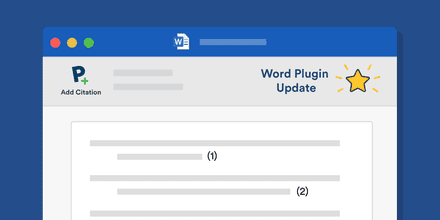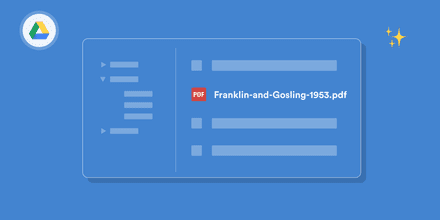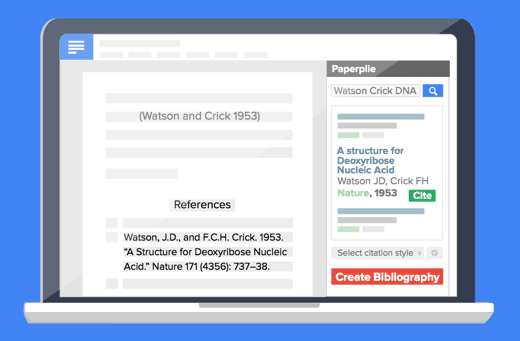
It’s been nearly two years since we released the first public version of Paperpile, a reference manager built from scratch for the web. During this time, Paperpile has grown into a fully featured tool used by thousands of researchers every day to find, collect, manage, read, annotate, share and write papers, boosting their academic productivity.
Today, we’re delighted to announce the release of a free fully featured citation manager as a standalone product that works with Google Docs, enabling you to collaboratively write papers and grants. Now everyone can add citations and bibliographies to a Google Doc, no account or sign-up is required.
Add our citation app in one click from the Google Docs add-on store!
Writing a paper in Google Docs the Paperpile way works like this:
- Install the Google Docs add-on
- Invite your colleagues to your documents and ask them to install the add-on.
- Add citations, here’s our cheat sheet
Collaborative writing needs collaborative citing
Many of us have observed that the author lists of academic papers are getting longer and longer. This is not surprising as science gets more interdisciplinary and collaborations grow. There has been some controversy surrounding the trend of “hyper authorship” with questions about the relative contributions of every author and the meaning of “authorship”.
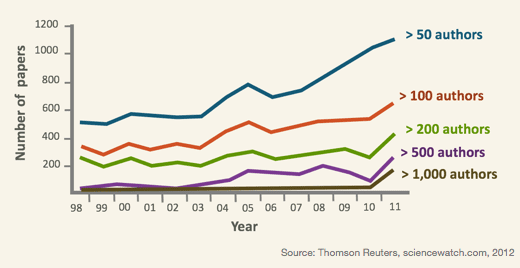
However, we’re more interested in the practical aspects of this debate. How do you write a paper with hundreds of authors in the first place? Even if only 10% of 200 authors of a paper actually take part in the writing there’s the not insignificant we are faced with the problem of 20 people editing the same document.
My story
With a background in genomics, I’ve personally been part of several big consortia. I remember only too well editing the manuscript and supplementary text on a weekend right before the deadline for the paper submission of the ModENCODE project. I was not alone, more than 10 others were writing at the same time in a Google Doc.
That was back in 2011 and by then Google Docs already had impressively solved the problem of collaborative writing. Unfortunately this was not the case for academics. Citations and references were, frankly, a mess.
At some point in this painful process, the document was exported to Word because some poor colleague had to use EndNote to compile all the references. While the writing was a truly collaborative experience, reference management was a one-person-job and team productivity was set back by many years!
The manuscript was then sent around via email, it could only be edited by one person at a time and it required many “manuscript_final3.docx” versions until final submission. And of course, for the revisions we re-imported to Google Docs and started this tedious process all over again…
Our solution
Paperpile is about academic productivity. Fixing collaborative writing is a big part of this equation. As a startup, we occupy this space with others like ShareLatex, Overleaf, and Authorea which provide authoring platforms for academics.
Our approach is different. Paperpile does not seek to replace Google Docs but rather to extend it and make it a first class platform for academic writing.
A free, fully-featured citation manager for Google Docs
What if there was a citation manager that came with multiple benefits and was as easy to use as Google Docs itself? Today we are launching our free Paperpile add-on for Google Docs, which we think comes very close:
- Free, can be added with one click from the Google Docs add-on store.
- No subscription or even sign-up required. Just use your Google account.
- Self-contained and fully-featured. Includes everything that’s required to prepare citations and bibliography for an academic paper.
- Fully collaborative, everyone can add, view and edit citations at the same time.
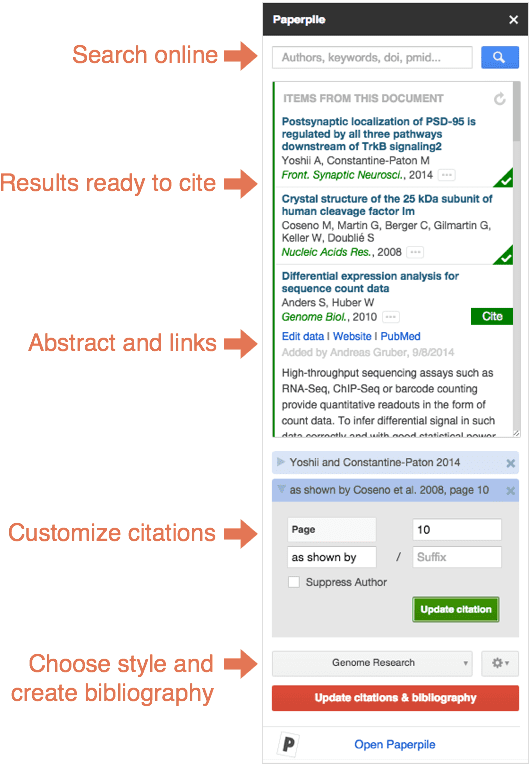
What can you do with the new add-on? The best way to find out is to try it out for yourself but here is a rundown of features:
- Search online for journal articles and books while writing the paper
- Look up PubMed IDs, DOIs and ISBNs
- Add citations and bibliographies with one click
- Supports all types of citations (in-text, footnotes, author-name, numeric, superscripts,…)
- Choose among all major citation styles like APA, Chicago, MLA and thousands of journal-specific styles
- Citations are customizable so that they fit in the sentence without getting lost when you re-format, e.g. “(see also Smith, 2002 and references therein)
- Supports italics and superscripts in the bibliography (e.g. for species names and chemical compounds)
- Cites journals and books and 29 other supported reference types including patents, websites, computer programs, data sets,..
- Export references as RIS or BibTeX for use with other reference managers (we don’t judge…)
- Export your document to Word and EndNote
- Export your document with citation commands suitable for use with LaTeX/BibTeX
- Get support at forum.paperpile.com
Writing my next paper in Google Docs, really?
Is this a good idea? Yes and we have the data to prove it!
Writing is part of every academic’s job. Actually it’s a mission critical part of it. Your career depends on the papers you publish, your financing depends on the grants you write and as a student your degree depends on your thesis.
We understand that there is some activation energy required to switch from a well-established workflow like Word and EndNote to something completely different like Google Docs and Paperpile.
That’s why we are very happy to see that so many of Paperpile customers actually made this switch. We did a survey and here are some statistics from a subset of paying customers.
If we extrapolate these results out, there are thousands of papers already published that were written with Paperpile and Google Docs.
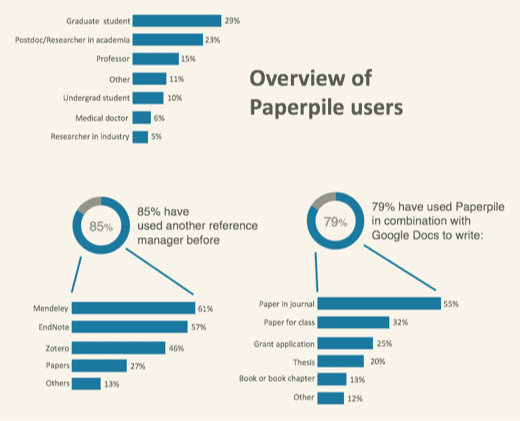
Success stories
We’ve improved Paperpile constantly over the past two years (e.g. here and here), mainly guided by user feedback. Along the way we’ve had more than 2,000 individual conversations with our users and heard many of their success stories.
Les Ansley reported how Paperpile helped him to write a collaborative paper across five European countries and eight institutions. He is Senior lecturer at Northumbria University and the paper is about Pathophysiological mechanisms of exercise-induced anaphylaxis.
Brady Allred, Professor of Rangeland Ecology at the University of Montana, used Google Docs and Paperpile to write his paper about “Ecosystem services lost to oil and gas in North America” published in Science this April.
Carlos Araya is a Postdoc at the Dept. of Genetics, Stanford University. His paper “Quantitative analysis of RNA-protein interactions on a massively parallel array reveals biophysical and evolutionary landscapes” was featured on the cover of Nature Biotechnology. This paper was entirely written in Google Docs and Paperpile.
Mara Lawniczak studies malaria as group leader at the Wellcome Trust Sanger Institute. She used Google Docs and Paperpile for a recent review. What did we learn from this review (except how genotypes are connected to medically relevant phenotypes in major vector mosquitoes of course…)? That there are still papers with just one author and also for this use case Paperpile is the best solution. She sent us a message: “Being able to say good bye forever to EndNote/Word is delightful. And the bells and whistles of Paperpile, yet its simplicity in use, make it sooooo nice.”
We’re happy to see how Paperpile helps so many people across different fields, countries and career stages. We could go on. There’s Nils Loewen Professor in the Department of Ophthalmology at the University of Pittsburgh who used Paperpile and Google Docs to write a successful $1M NIH grant or Thomas Secher and undergrad student who wrote his master’s thesis in marketing at Stockholm Business School in Google Docs…
What’s new for existing Paperpile subscribers?
Our Chrome extension allowed Paperpile subscribers to add citations to their Google Docs since day one, this is how it looks. Nothing will change about our Chrome extension and how it integrates with Google Docs. We will keep improving it because it offers crucial features like the very powerful popup citation dialog or keyboard shortcuts.
The new sidebar add-on announced today can be safely used in parallel and adds several new features like the frequently requested EndNote export. The side-bar view also gives you a better overview of existing citations and makes it easier to add multiple citations from a single search result (another popular feature request).
Most importantly, however, the new add-on allows all your co-authors to fully participate in the citation process even if they have not switched (yet) to Paperpile as their main reference manager. The sidebar add-on is completely self-contained and does not require a paid subscription. Paid subscriptions remain unchanged and offer all advanced features you expect from a modern reference manager.
